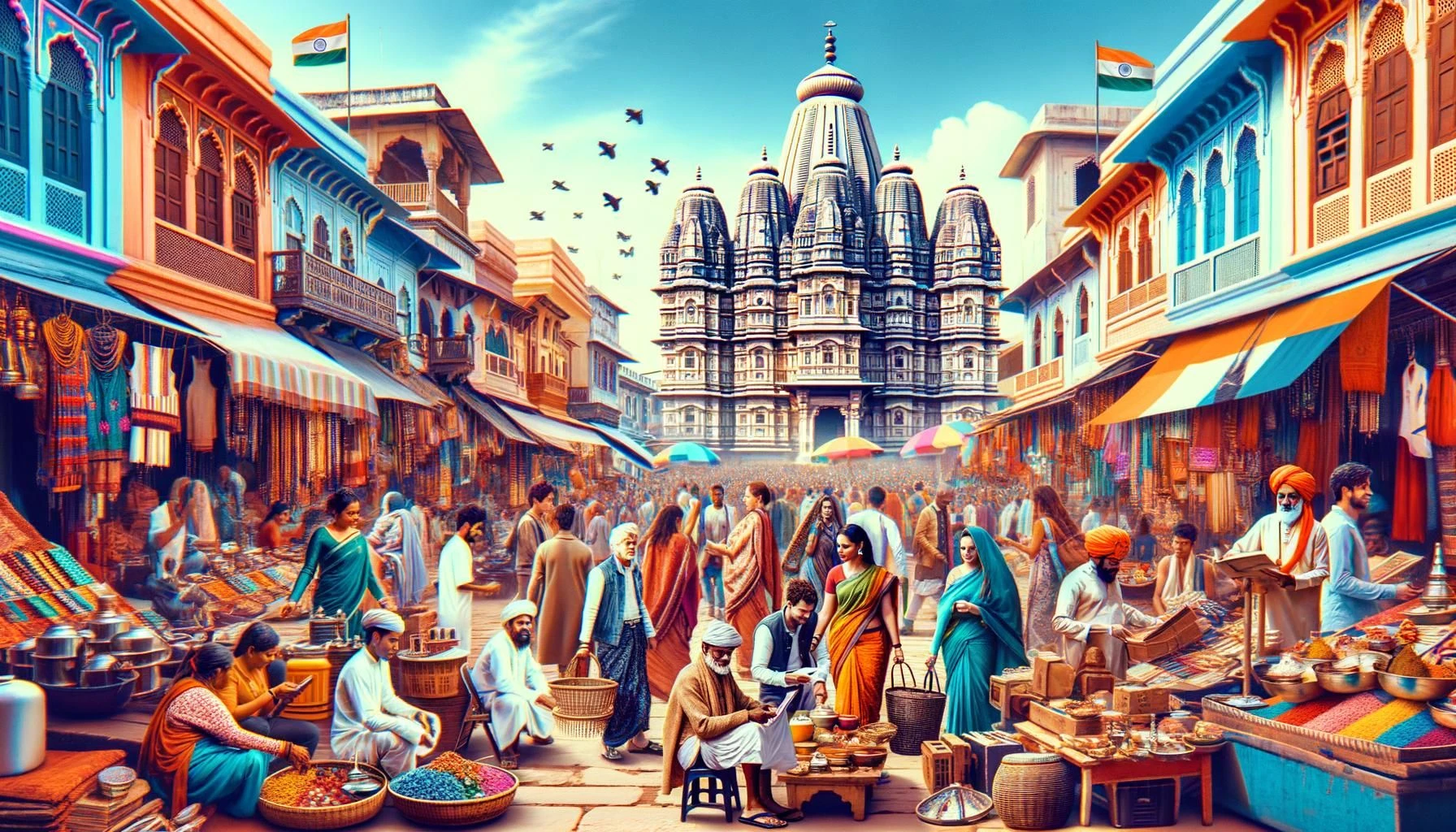Published by Contentify AI
- Introduction
- Best Time to Visit India
- Top Destinations to Explore
- Cultural Experiences
- Traditional Cuisine
- Travel Tips
- Packing Essentials
- Budget-Friendly Options
- Conclusion

Introduction
India is a land of diverse cultures, vibrant traditions, and breathtaking landscapes, making it a top choice for travelers worldwide. From the snow-capped peaks of the Himalayas to the sun-kissed beaches of Goa, this country offers experiences that cater to every kind of traveler. This complete guide will provide you with essential information and tips to make the most out of your journey. Whether you are a history buff, a foodie, or an adventure enthusiast, traveling to India promises an unforgettable experience filled with rich heritage and endless adventures.
Best Time to Visit India
India’s vast and varied landscape means that the best time to visit largely depends on the region you plan to explore. Generally, the most comfortable period to travel is during the cooler months from October to March. During this time, the weather is pleasant across most of the country, making it ideal for sightseeing and outdoor activities.
In the northern regions, including the Himalayan states of Himachal Pradesh and Uttarakhand, as well as popular destinations like Delhi and Rajasthan, winter offers crisp air and clear skies. This is also the best time to visit famous festivals such as Diwali and Holi, which provide an immersive cultural experience.
For those heading to the southern parts of India, including Kerala, Tamil Nadu, and Karnataka, the winter months still hold favorable weather, although these regions are also quite enjoyable during the monsoon season from June to September. The monsoons bring lush greenery and fewer tourists, offering a more serene experience.
If you’re planning to visit the coastal areas, such as Goa and the Andaman Islands, the dry season from November to February is perfect for beach activities and water sports.
Traveling to India: A Complete Guide suggests that while the peak tourist season is optimal for weather and festivals, those who prefer fewer crowds might consider the shoulder seasons of April and September. These months offer a balance between manageable weather and less tourist congestion.
Choosing the right time to visit India ensures that your journey is not only comfortable but also rich in experiences, whether you are trekking through mountain trails or exploring historic cities.
Discover Prabhas’s Impact
Learn about the rise of Prabhas in the film industry and why many consider him unmatched. Explore exclusive behind-the-scenes insights and interviews.
Top Destinations to Explore
India is home to a myriad of destinations that cater to diverse interests and preferences. One of the most iconic places to visit is the Taj Mahal in Agra, a symbol of love and an architectural marvel. Rajasthan, known for its royal palaces and forts, provides a glimpse into the country’s regal past with cities like Jaipur, Udaipur, and Jodhpur offering unique experiences.
For nature enthusiasts, the state of Kerala is a must-see with its serene backwaters, lush tea plantations, and pristine beaches. The hill stations of Himachal Pradesh and Uttarakhand, such as Shimla, Manali, and Rishikesh, offer breathtaking landscapes and adventure activities like trekking and river rafting.
The bustling metropolis of Mumbai, the financial capital of India, boasts a vibrant nightlife, historic landmarks, and a stunning coastline. In contrast, Varanasi, one of the oldest living cities in the world, provides a spiritual journey along the ghats of the sacred Ganges River.
Goa is the ultimate destination for beach lovers, with its sandy shores, vibrant nightlife, and Portuguese heritage. For those interested in ancient history and spirituality, the temples of Tamil Nadu and the ruins of Hampi in Karnataka are unmissable.
Traveling to India: A Complete Guide would be incomplete without mentioning the northeastern states, which are often less explored but equally captivating. Places like Kaziranga National Park in Assam and the living root bridges of Meghalaya offer unique experiences away from the usual tourist trails.
Each destination in India offers something distinct, ensuring that your travel experience is as diverse as the country itself.
Related articles
Cultural Experiences
Immerse yourself in India’s rich tapestry of cultures through a variety of unique and unforgettable experiences. Start by participating in the vibrant festivals that dot the Indian calendar. Diwali, the Festival of Lights, and Holi, the Festival of Colors, are celebrated with exuberance across the country and offer a fascinating glimpse into Indian traditions and community spirit.
A visit to India is incomplete without exploring its diverse religious practices. The country is home to numerous spiritual hubs like Varanasi, where the evening Ganga Aarti (river worship ceremony) offers a mesmerizing display of devotion. Similarly, the Golden Temple in Amritsar provides a serene experience and an opportunity to participate in the community kitchen, serving meals to thousands daily.
Indian classical music and dance forms are integral to the cultural landscape. Attend a Bharatanatyam dance performance in Tamil Nadu or a Kathak recital in Uttar Pradesh to appreciate the intricate storytelling through movement and rhythm. In regions like Rajasthan, folk performances featuring traditional instruments like the tabla and sitar add another layer to the cultural experience.
Handicrafts are another vital aspect of India’s cultural heritage. In cities like Jaipur and Udaipur, local markets brim with handcrafted jewelry, pottery, and textiles. A visit to these markets not only allows for unique souvenirs but also supports local artisans keeping age-old traditions alive.
To truly delve into the everyday culture, consider staying in a homestay. This will give you the chance to interact closely with an Indian family, partake in home-cooked meals, and learn about customs and traditions firsthand. Whether it’s celebrating a local festival, learning how to cook traditional dishes, or simply engaging in conversation, homestays offer invaluable insights into Indian life.
Traveling to India: A Complete Guide suggests that these cultural experiences are more than just activities; they are opportunities to connect deeply with the soul of the country. Each encounter adds a layer of understanding and appreciation for India’s rich and diverse heritage.
Traditional Cuisine
India’s traditional cuisine is a culinary journey that reflects its diverse culture and regional variations. Each state offers a unique gastronomic experience that is sure to tantalize your taste buds. In the north, you can savor rich, creamy dishes like butter chicken and biryani, accompanied by soft, fluffy naan bread. The use of aromatic spices such as cardamom, cloves, and cumin is prominent, providing a depth of flavor that is quintessential to Indian cooking.
Traveling to India: A Complete Guide would be incomplete without mentioning the spicy and tangy flavors of South Indian cuisine. Dishes like dosa, idli, and sambar, often served with coconut chutney, are staples. The coastal regions, especially Kerala and Goa, offer an array of seafood delicacies, richly flavored with coconut milk and regional spices.
In the western part of India, particularly Gujarat and Maharashtra, the cuisine tends to be a mix of sweet, savory, and spicy flavors. Gujarati thali, a platter consisting of various dishes, gives you a comprehensive taste of the local fare, including items like dhokla, khandvi, and theplas. Maharashtra’s street food, such as pav bhaji and vada pav, is a must-try, offering a burst of flavors and textures.
Eastern India, including Bengal and Odisha, is known for its love of sweets and fish. Bengali sweets like rasgulla and sandesh are world-famous, while dishes like macher jhol (fish curry) highlight the region’s expertise in melding spices with fresh ingredients.
Street food in India is an experience in itself. Sampling chaats from a roadside vendor in Delhi or Mumbai can be as exciting as dining in a high-end restaurant. From pani puri to samosas, the variety and innovation are endless.
Understanding and indulging in traditional Indian cuisine is an essential part of Traveling to India: A Complete Guide. Each meal tells a story of the region’s history, traditions, and lifestyle, making your culinary adventures as enriching as the places you visit.
Travel Tips
When preparing for your journey, a few essential travel tips can significantly enhance your experience. First and foremost, ensure you have a valid visa before arriving, as India requires visas for most foreign nationals. It’s advisable to apply well in advance to avoid any last-minute hiccups.
Staying healthy while traveling to India is crucial. Make sure to drink only bottled or filtered water and avoid ice in drinks unless you are certain of its source. Street food is an integral part of the Indian experience, but it’s best to eat from popular, well-reviewed stalls to minimize the risk of foodborne illnesses.
Respecting local customs and traditions is essential. In many religious sites, modest dress is required, and shoes must be removed before entering temples and mosques. A lightweight scarf can be handy for covering your head when needed.
Transportation in India can be an adventure in itself. While trains offer a scenic and economical way to travel long distances, booking tickets in advance is recommended, especially during peak travel seasons. For shorter trips within cities, ride-sharing apps like Uber and Ola are reliable options. Auto-rickshaws are also ubiquitous, but always negotiate the fare beforehand or ensure the driver uses the meter.
Safety is another priority. While India is generally safe for tourists, it’s wise to remain vigilant. Keep your valuables secure, avoid isolated areas after dark, and be cautious when accepting food or drinks from strangers. Women travelers might benefit from joining organized tours or staying in accommodations that cater specifically to solo female travelers.
Having local currency on hand is essential, as not all shops and restaurants accept credit cards. ATMs are widely available, but it’s a good idea to inform your bank of your travel plans to avoid any issues with international transactions.
A comprehensive health and travel insurance plan is indispensable when traveling to India: A Complete Guide recommends it to cover medical expenses, trip cancellations, and any unforeseen events.
Lastly, keeping an open mind and being adaptable can transform your trip into a memorable adventure. India is a country of contrasts and surprises, and embracing its complexities will enrich your travel experience immensely.
Packing Essentials
When preparing for your trip, packing the right essentials can make a significant difference in your comfort and convenience. Firstly, consider the varied climate across different regions and seasons. Lightweight, breathable clothing is ideal for most parts of India, especially during the hotter months. However, if you’re traveling to northern areas or hill stations, pack some warm layers as temperatures can drop significantly.
A reliable pair of walking shoes is crucial, given the amount of exploring you’re likely to do. Whether you’re wandering through bustling markets or hiking scenic trails, comfortable footwear will be your best friend. Additionally, a compact, sturdy backpack can be helpful for day trips and excursions.
Traveling to India: A Complete Guide suggests carrying a basic first aid kit, including medications for common ailments like stomach upset, headache, and allergies. Over-the-counter medications might not always be readily available, and having your own supply can save you a lot of trouble. Don’t forget a good insect repellent, especially if you plan to visit rural areas or go on nature treks.
Given the importance of staying connected, a universal power adapter is indispensable. India uses a mix of plug types, so it’s better to be prepared. Also, consider buying a local SIM card upon arrival for affordable data and calls, which can be easily purchased at the airport or local stores.
Sun protection is another must. Sunscreen, sunglasses, and a wide-brimmed hat will help you stay protected from the harsh sun, especially during outdoor activities. A reusable water bottle with a built-in filter can be a lifesaver, given the importance of staying hydrated and the advisability of drinking purified water.
For those interested in documenting their journey, a good quality camera or smartphone with ample storage will help you capture the vibrant moments of your trip. Carrying a portable charger or power bank ensures your devices remain charged throughout the day.
Lastly, important documents such as your passport, visa, travel insurance, and a few copies of these should be kept in a secure, waterproof pouch. It’s also wise to have both digital and physical copies of your travel itinerary, emergency contacts, and accommodation details.
By packing these essentials, you can ensure that your trip to India is comfortable, safe, and thoroughly enjoyable.
Budget-Friendly Options
For those looking to explore this vibrant country without breaking the bank, there are plenty of budget-friendly options available. One of the most cost-effective ways to travel is by utilizing the extensive train network. Indian Railways offers a range of classes to fit every budget, from the luxurious first-class AC to the more economical sleeper class. Booking tickets in advance can save you even more money and ensure you have a confirmed seat.
Opting for local eateries and street food is another great way to keep expenses low while getting an authentic taste of Indian cuisine. Dishes from roadside vendors or small restaurants often cost a fraction of what you’d pay in more tourist-heavy spots, yet offer incredible flavors. Just be mindful of hygiene and choose stalls that are popular with locals to ensure the food is fresh and safe.
Accommodation doesn’t have to be a drain on your resources either. Budget hotels, hostels, and guesthouses are plentiful in most cities and offer clean, basic amenities. Websites and apps like Hostelworld, Airbnb, and Booking.com can help you find affordable lodging options. Additionally, homestays provide the dual benefit of lower costs and a more immersive cultural experience.
Public transportation within cities, such as buses, metros, and auto-rickshaws, is both economical and efficient. For instance, the Delhi Metro and Mumbai’s local trains offer an affordable way to navigate these sprawling metropolises. Just be prepared for crowded conditions during peak hours. Ride-sharing apps like Uber and Ola also provide budget-friendly options for short-distance travel.
Another tip from Traveling to India: A Complete Guide is to take advantage of the numerous free or low-cost attractions. Many temples, parks, and markets don’t charge an entry fee, allowing you to experience the local culture without spending a dime. Historical sites like the Gateway of India in Mumbai and India Gate in Delhi are iconic landmarks that you can visit for free.
Shopping for souvenirs and local crafts can be done on a budget if you know where to go. Street markets and bazaars offer a wide range of affordable goods, from textiles to handicrafts. Always be ready to bargain, as haggling is a common practice in Indian markets and can lead to significant savings.
By planning wisely and taking advantage of these budget-friendly options, you can experience the richness of India without straining your finances. This approach ensures that traveling to India is accessible to everyone, offering a remarkable journey through one of the world’s most diverse and captivating countries.
Conclusion
Traveling to India can be an incredibly rewarding experience, filled with vivid landscapes, rich history, and diverse cultures. As you wrap up your journey, you’ll likely find that India’s vastness and variety have left you with countless memories and new perspectives. Reflecting on the experiences from the bustling alleys of Delhi to the tranquil backwaters of Kerala, it becomes evident that this country offers something for every type of traveler.
One crucial takeaway from Traveling to India: A Complete Guide is the importance of planning and adaptability. Whether you navigated through the peak tourist season or found serenity in the off-peak months, your preparedness would have significantly influenced your travel experience. By following the tips and suggestions provided, you likely managed to enjoy the best that India has to offer while avoiding common pitfalls.
Exploring India’s top destinations, from the architectural grandeur of the Taj Mahal to the spiritual vibes of Varanasi, would have enriched your understanding of the country’s multifaceted identity. Each place has its own story, adding layers of depth to your journey. Similarly, engaging in cultural experiences such as attending local festivals or enjoying traditional performances would have offered an immersive peek into the vibrant Indian way of life.
Sampling the diverse cuisine, with its regional specialties and street food delights, undoubtedly played a significant role in your adventure. The flavors of India, ranging from the spicy curries of the north to the coconut-infused dishes of the south, are sure to linger in your memory, reminding you of the culinary richness that forms an integral part of Indian culture.
Traveling to India on a budget is entirely feasible, as highlighted in this guide. By leveraging affordable transport options, budget accommodations, and cost-effective dining choices, you could enjoy an authentic experience without overspending. This approach allows travelers to fully appreciate India’s diversity without financial strain, making it accessible to a wide range of visitors.
In sum, Traveling to India: A Complete Guide has aimed to equip you with all the necessary information to make your journey enjoyable, enriching, and memorable. As you conclude your travels, you’ll likely find that India has left an indelible mark on your heart, encouraging you to return and explore even more of this incredible country in the future.













Leave a Reply